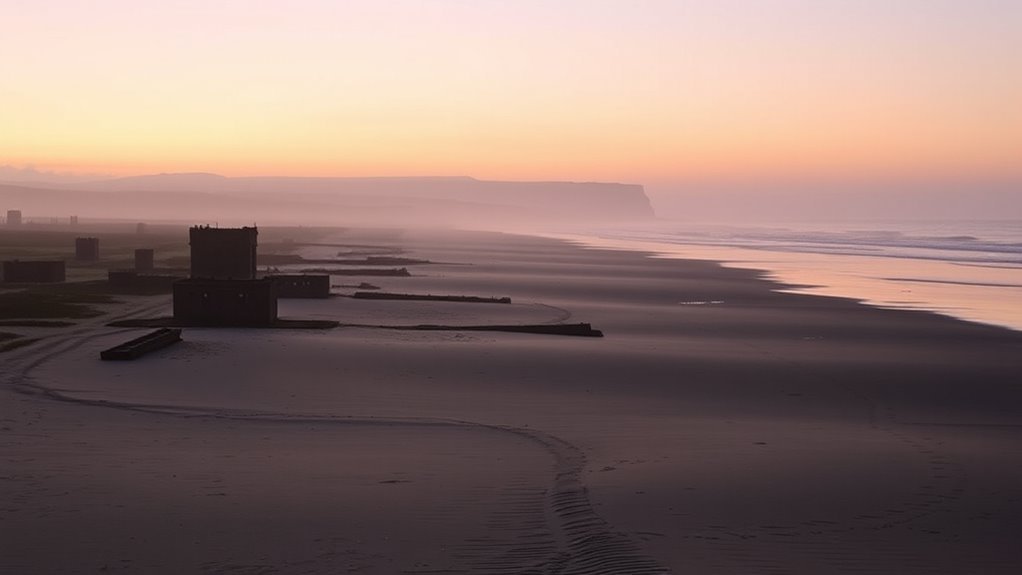Imagine standing on the sands of Omaha Beach, where the fate of Europe once hung in delicate balance. The sheer cliffs, fortified positions, and deadly “killing zone” tell a haunting tale of courage and sacrifice. As an Allied soldier, you’re faced with relentless gunfire and chaotic landings. Yet, amidst the chaos, there’s a story of extraordinary bravery and a pivotal victory that shaped the course of history. What unfolded here changed everything.
Key Takeaways
- Omaha Beach, part of the Normandy Invasion on June 6, 1944, was a critical site for the Allied D-Day landings.
- The beach was defended by formidable German forces, including strongpoints, barbed wire, and mines, presenting significant challenges to the attackers.
- American forces faced heavy casualties, with approximately 2,400 soldiers lost to German defenses on D-Day.
- Despite initial setbacks, 34,000 American troops successfully established a beachhead, securing an 8-kilometer stretch for further operations.
- The successful assault on Omaha Beach was pivotal to the Allied campaign, contributing significantly to the eventual liberation of Western Europe during World War II.
Terrain and Defenses
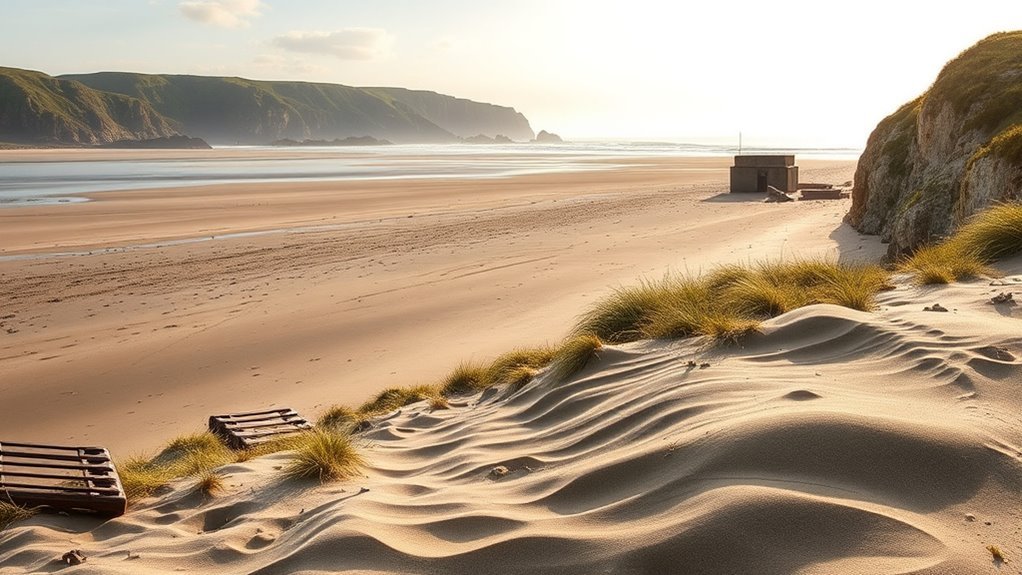
Although the picturesque crescent shape of Omaha Beach might’ve seemed inviting, it was anything but welcoming during the invasion. The terrain was treacherous, featuring a 300-meter-wide tidal area and cliffs that towered 30 meters high.
The German 352nd Infantry Division had fortified the area with 13 strongpoints and extensive trenches. They transformed the beach into a deadly fortress. Barbed wire, anti-tank walls, and Belgian Gates with mines littered the landscape, creating significant obstacles.
Artillery fire rained down, forming a “killing zone” that decimated advancing troops. The rough ground, coupled with a 3-meter seawall, compounded the challenges faced by attackers.
As you envision the chaos, understand that the defenses were expertly designed to inflict maximum casualties on the Allies.
Assault Plan and Naval Component
The formidable defenses of Omaha Beach required an audacious and meticulously crafted assault plan to overcome them. The assault was organized into ten sectors, with codenames like Charlie USDog, and involved the U.S. 1st and 29th Infantry Divisions.
These divisions, supported by Ranger battalions and tank units, aimed to breach the German defenses. The naval component, led by Task Force O under Rear Admiral John L. Hall Jr., consisted of 1,028 vessels. They played a vital role in transporting troops and providing artillery support during the landings.
Pre-landing bombardments started at 05:50 on June 6, 1944, but struggled due to overcast skies. Despite these challenges, the assault plan demonstrated immense coordination and bravery in the face of formidable odds.
Initial Assault and Challenges
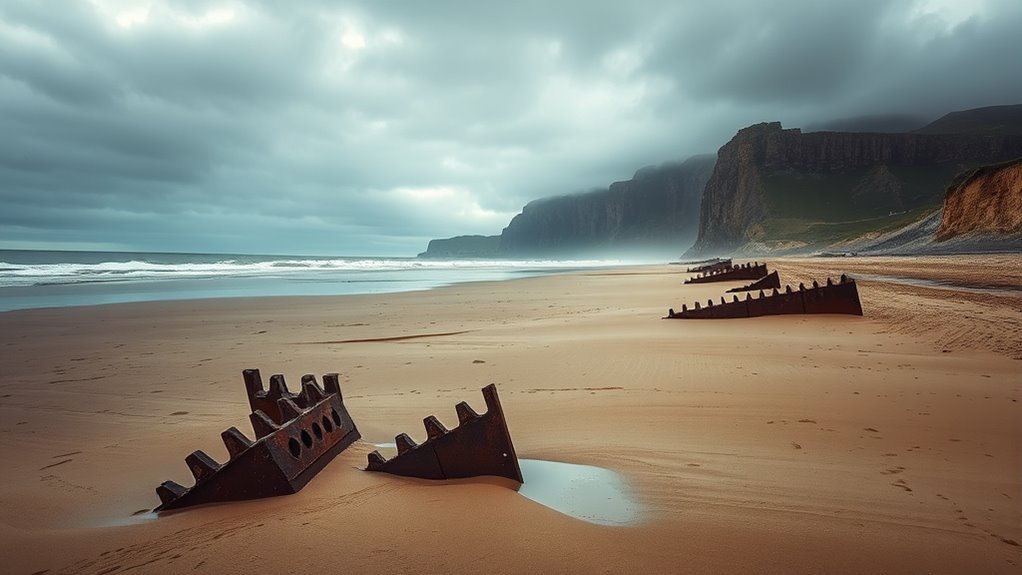
As the initial assault on Omaha Beach commenced at 06:30 on June 6, 1944, troops immediately faced intense gunfire and heavy resistance from well-entrenched German positions.
The chaos was apparent as only two out of 29 landing craft reached their designated areas. Strong winds and rough seas pushed many landing craft off course, and as soldiers disembarked, they were met with relentless enemy fire.
The pre-landing naval bombardment had been largely ineffective, leaving resistance nests well-fortified and contributing to severe casualties.
Approximately 2,400 American casualties occurred on D-Day, with around 1,000 killed.
Soldiers scrambled for cover behind obstacles, trying to regroup amid the confusion. You can imagine the fear and urgency as they struggled against the overwhelming odds.
Tank, Infantry, and Engineer Landings
As you explore the tank, infantry, and engineer landings at Omaha Beach, you’ll notice that the assault’s timing played a crucial role in its challenges.
Rough seas and harsh German defenses led to disorganization and significant casualties, particularly when many landing craft missed their designated zones.
Despite these obstacles, engineers bravely cleared paths; however, coordination issues and high losses significantly impacted their effectiveness and the overall operation.
Assault Timing and Challenges
On the morning of June 6, 1944, chaos unfolded as the initial assault on Omaha Beach began at 06:30.
As part of the seaborne assault, troops wade ashore under intense gunfire support, facing immediate heavy casualties. The beach landing turned perilous with rough seas swamping many landing craft. Confusion reigned as soldiers struggled to find their bearings amidst relentless enemy fire.
Only five out of 16 engineer teams reached their designated spots, attempting to clear obstacles while under heavy fire. The second wave, arriving at 07:00, faced similar challenges, further compounding the earlier setbacks.
Despite these initial trials, by noon, American forces began scaling the bluffs, clearing paths, and establishing a vital foothold for further inland advances.
Coordination and Casualty Impact
Despite the initial chaos and challenges faced during the assault timing, the coordination of tank, infantry, and engineer landings played a pivotal role in the unfolding events at Omaha Beach.
The American landing faced severe coordination hurdles; only 5 out of 16 engineer teams reached their posts, leading to high casualties when clearing obstacles. The infantry, facing intense German fire, suffered approximately 2,400 casualties on D-Day.
Rough seas swamped many landing crafts, and only 2 of 29 arrived as planned, hampering the assault’s effectiveness. As the second wave began, survivors were unable to provide effective covering fire, which increased attrition among the landing craft.
Yet, despite these overwhelming challenges, American troops scaled the bluffs, gaining a foothold on the inland terrain.
Second Assault Wave Dynamics
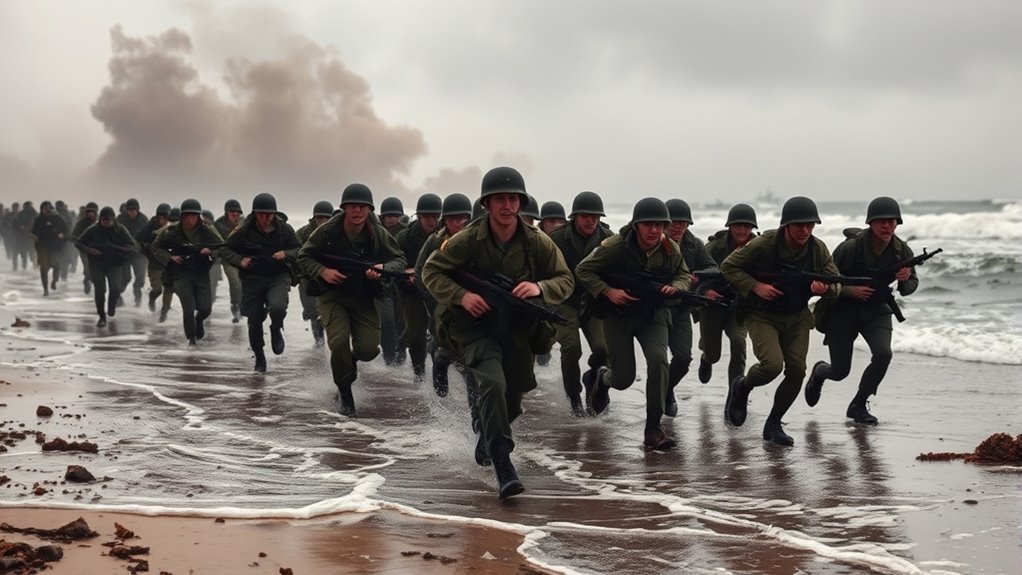
As you consider the dynamics of the second assault wave at Omaha Beach, it’s vital to understand the navigation challenges faced by the landing craft.
Many were swamped or misdirected, resulting in disorganized infantry landings and hindering coordination efforts.
Despite these difficulties, the troops’ tenacity eventually helped establish a foothold, setting the stage for further advances.
Landing Craft Navigation Challenges
Steering through the turbulent waters off Omaha Beach, the second assault wave faced significant challenges that disrupted their mission.
Strong tidal currents and rough seas made maneuvering the landing craft extremely difficult. These navigation challenges resulted in many crafts being misdirected, preventing them from reaching their intended sectors.
This misdirection led to disorganization among the troops, worsening the assault dynamics. Survivors from the first wave couldn’t provide effective covering fire, leaving the second wave exposed and leading to high casualties.
Only five out of 16 engineer teams reached their designated locations, suffering significant losses.
The chaotic conditions and high attrition rates during the second wave resulted in many units becoming separated, exacerbating the already dire situation on Omaha Beach.
Infantry Coordination Difficulties
While the clock struck 07:00, the second wave of landings at Omaha Beach plunged into chaos. Just as in the first, many infantry units struggled with navigation, resulting in severe coordination issues.
Survivors from the initial assault couldn’t offer effective covering fire due to their heavy casualties and relentless German defenses. This disorganization left troops separated from their headquarters, severely hindering communication and tactical execution.
Most landing craft missed their targets, and only five of the 16 engineer teams successfully reached their designated spots to clear the obstacles. This further complicated the already chaotic scene.
High attrition rates among landing craft meant many troops couldn’t establish effective positions. The fortified German defenses capitalized on these missteps, intensifying the struggle for control on Omaha Beach.
Breakthrough and Assaulting the Bluffs
The assault on the bluffs at Omaha Beach marked a pivotal moment on June 6, 1944. As troops landed, they faced the formidable task of scaling 30-meter-high cliffs under heavy fire from German defenses. The terrain was treacherous, and despite naval gunfire aimed at suppressing enemy positions, the soldiers encountered fierce resistance.
| Challenges | American Response |
|---|---|
| Cliffs | Scaling the escarpment |
| Machine gun fire | Naval gunfire support |
| Artillery | Persistent advance |
| Fortified points | Flanking maneuvers |
| Strong resistance | Securing exits |
Establishing the Beachhead
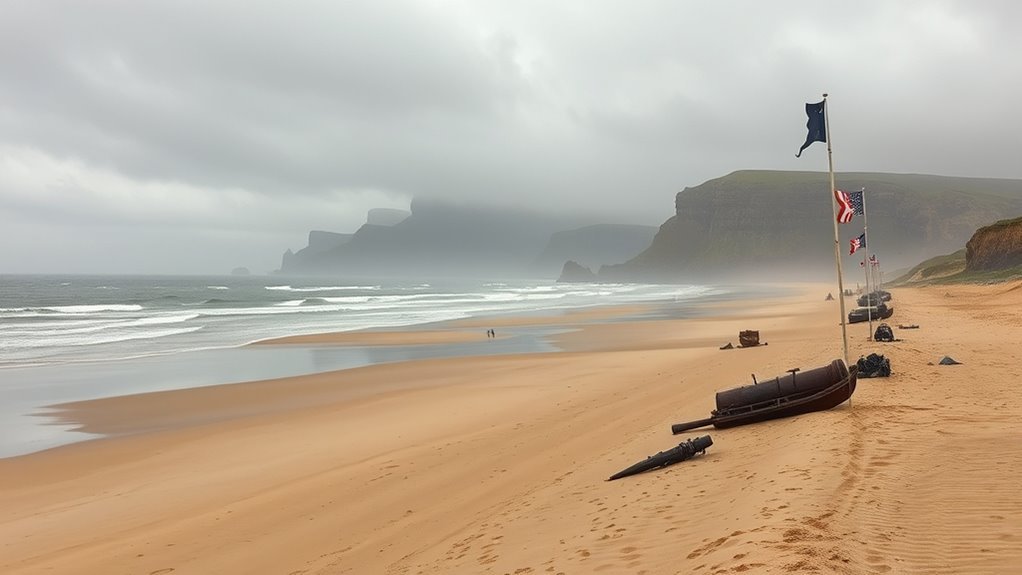
After overcoming the challenging terrain and fierce German defenses, American forces faced the formidable task of establishing a beachhead at Omaha Beach. The objective was to secure an 8-kilometer stretch to support the amphibious assault and advance the US inland on D-Day.
The U.S. Army’s 29th Infantry Division and Rangers tackled the western sectors, while the 1st Infantry Division hit the eastern side. Despite rough seas and heavy fire leading to around 2,400 casualties, you witnessed American troops scaling cliffs and securing positions in Vierville, Saint-Laurent, and Colleville.
German Reactions and Inland Defenses
Despite the initial shock of the Allied invasion, German forces at Omaha Beach quickly regrouped to mount a fierce defense.
The German 352nd Infantry Division effectively utilized its strongpoints and extensive trench systems, creating a formidable barrier. They coordinated fire from machine gun nests and artillery on the cliffs, turning the beach into a deadly “killing zone” and inflicting heavy casualties on the American troops.
As the battle progressed, German soldiers maintained their defensive positions and launched counterattacks to resist the advancing Allied forces. Although they suffered significant casualties themselves, their tactical responses resulted in approximately 2,400 American casualties on D-Day.
Limited reinforcements hindered their ability to launch larger counteroffensives, but their initial reactions showcased a determined defense.
End of Day and Aftermath
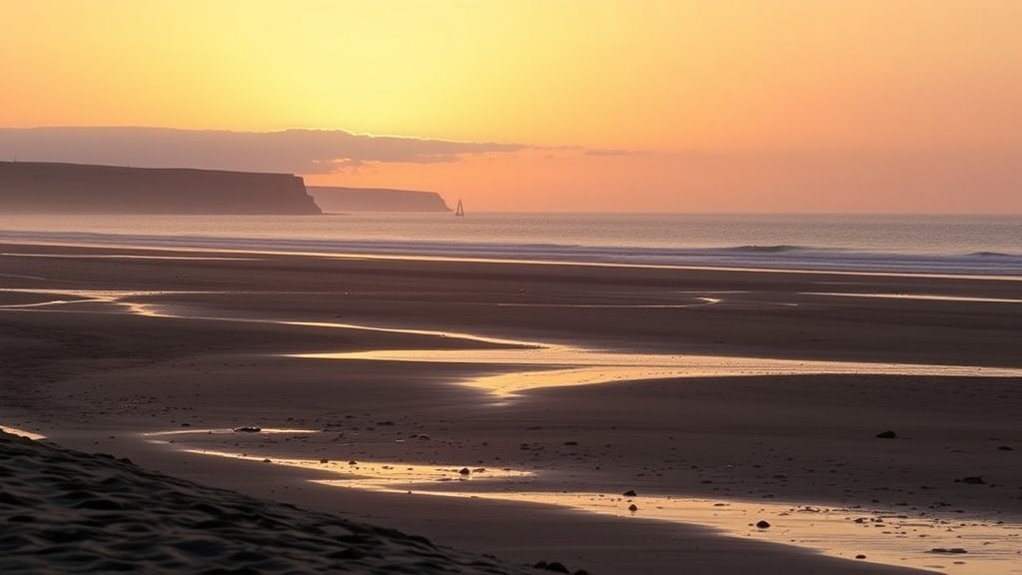
By the end of D-Day, American forces landed around 34,000 troops on Omaha Beach, an essential step despite facing fierce resistance.
American casualties were staggering, with about 4,100 soldiers affected, yet the 1st and 29th Infantry Divisions secured key positions near Vierville, Saint-Laurent, and Colleville.
German defenses, though initially robust, weakened by noon, allowing troops to advance a mile and a half inland.
The establishment of a beachhead at Omaha Beach was decisive for the Normandy campaign, marking a strategic victory.
- Sacrifice and bravery: Many soldiers faced intense fire, with high casualties reflecting their courage.
- Strategic advancement: Securing the beachhead was critical for future operations.
- Tactical success: Overcoming defenses was a testament to determination.
- Historical impact: The success of Omaha Beach fueled the broader Allied invasion.
Conclusion
You’ve navigated the treacherous terrain of Omaha Beach, where Allied forces faced formidable German defenses and overwhelming odds. Despite the chaos and intense gunfire, American soldiers’ bravery and relentless determination broke through the enemy’s stronghold. They’ve secured a vital foothold, paving the way for the liberation of Europe. With the establishment of the beachhead, you’ve witnessed a turning point in the war, as the tide shifts in favor of the Allies, setting the stage for future victories.
FAQs
1. How Many US soldiers died at Omaha Beach?
You’re asking about the number of U.S. soldiers who died during a significant World War II battle. On that day, about 1,000 American soldiers lost their lives amidst fierce resistance, contributing to around 2,400 total casualties.
2. Why Is Omaha Beach so Famous?
You know it’s famous because it symbolizes bravery and sacrifice during World War II. American troops faced fierce resistance, high casualties, and challenging terrain. Their courage is commemorated by memorials that honor the efforts that secured a vital beachhead.
3. Are Normandy and Omaha Beach the Same?
You might think Normandy and Omaha Beach are the same, but they’re not. Normandy’s a larger region where the Allies landed, and Omaha Beach is just one part of it, known for its intense battles and high casualties.
4. Can You Swim at Omaha Beach?
You can swim there, but be sure to check the weather and tide reports first. The water is cold, and the currents are strong. Lifeguards are present in the summer; please swim in designated areas for your safety.
Related Article
Leaf Peeping in Maggie Valley, North Carolina
Hidden Gems in Hilton Head, SC
